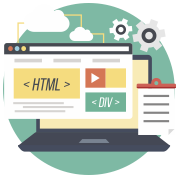Conducting A Website Needs Analysis
Conducting a website analysis is a great way to understand the specific requirements of your target audience as a scientific illustrator. It helps you tailor your website to meet their needs, ensuring a positive user experience. Let me guide you through these steps:
Step 1: Define your target audience
Gather all the information you collected in section 2 of Module 2, where you took on the task of clearly defining your target market. Take a close look at it to keep it in mind as you begin planning your website. Let's dive into the details and ensure that your website reflects the needs and preferences of your target audience.
Step 2: Research and gather information
To conduct a thorough website needs analysis, you need to gather information about your target audience. Start by researching their interests, demographics, and preferences. Look for online communities, forums, or social media groups where they gather to discuss scientific topics. Engage with them, ask questions, and observe their conversations to gain insights into their challenges and interests.
Step 3: Identify common goals and objectives
Once you have a good understanding of your target audience, it's time to identify their common goals and objectives when visiting a scientific illustrator's website. For example, researchers might be looking for high-quality illustrations to enhance their publications, while students may need educational resources to support their studies. By identifying these goals, you can ensure that your website meets their specific needs.

Step 4: Analyze competitors and industry standards
Take a close look at your competitors' websites and analyze how they cater to the needs of your target audience. Pay attention to the layout, navigation, content, and overall user experience. This analysis will help you identify industry standards and best practices, allowing you to differentiate yourself and create a unique website that stands out.
Step 5: Create user personas
User personas are fictional representations of your target audience segments. Based on your research and analysis, develop a few personas that represent the different types of visitors to your website. Give them names, backgrounds, and specific goals. For example, "Scientist Sarah" might be a senior researcher looking for detailed illustrations for a groundbreaking paper.
Step 6: Conduct user surveys or interviews
To gain deeper insights, consider conducting user surveys or interviews. You can create an online survey with questions related to their expectations, preferences, and any pain points they've encountered when searching for scientific illustrations. Alternatively, you can conduct one-on-one interviews to gather qualitative feedback. This direct interaction will provide valuable insights into their needs and frustrations.

Step 7: Analyze website analytics
If you already have a website, analyze your website analytics to gather data about your visitors. Look for patterns in their behavior, such as which pages they visit the most, how long they stay on each page, and what actions they take. This data will help you identify areas of your website that are performing well and areas that may need improvement.
Step 8: Synthesize and prioritize findings
Now that you have gathered all the information, it's time to synthesize and prioritize your findings. Identify common themes, pain points, and opportunities that emerged from your research. Prioritize these findings based on their importance and relevance to your target audience. This will guide you in making informed decisions about the design, content, and functionality of your website.
Remember, conducting a website needs analysis is an ongoing process. As your target audience evolves, continue to gather feedback, monitor industry trends, and adapt your website accordingly. By putting your audience's needs first, you'll create a website that not only meets their expectations but also establishes you as a trusted and valuable resource in the scientific illustration field.
The Importance Of Hiring A Web Designer To Plan And Design Your Website
Hiring a web designer to plan and design a user-friendly website is a wise investment that can have a significant impact on your online presence. Let's delve into the importance of working with a web designer:
Professional expertise:
Web designers are professionals who specialize in creating visually appealing and functional websites. They possess the knowledge and skills to transform your ideas into a polished and user-friendly website. By hiring a web designer, you benefit from their expertise in areas such as user experience (UX) design, responsive layouts, and effective visual communication.
User-centric approach:
A web designer brings a user-centric approach to the table. They understand the importance of creating a website that caters to the needs and preferences of your target audience. They consider factors like intuitive navigation, clear information hierarchy, and engaging visual elements to ensure a positive user experience. By putting your audience first, a web designer helps you create a website that resonates with your visitors.
Tailored design and branding:
As a scientific illustrator, you have a unique style and brand that sets you apart. A web designer collaborates with you to incorporate your artistic identity into the website design. They work closely with you to understand your aesthetic preferences, color schemes, and overall visual language. The result is a tailored design that aligns with your brand and effectively showcases your scientific illustrations.
Optimized functionality:
Functionality is a crucial aspect of a user-friendly website. A web designer ensures that your website functions smoothly and efficiently. They implement features and functionalities that enhance the user experience, such as intuitive navigation menus, search bars, contact forms, and interactive elements.

A web designer's technical expertise ensures that these functionalities work seamlessly across different devices and browsers.
Mobile responsiveness:
In today's mobile-driven world, having a mobile-responsive website is paramount. Web designers are well-versed in creating websites that adapt and look great on various screen sizes, including smartphones and tablets. They optimize the design and layout to ensure a consistent and engaging experience for visitors, regardless of the device they use. A mobile-responsive website increases accessibility and extends your reach to a wider audience.
Visual storytelling:
As a scientific illustrator, your visuals play a crucial role in conveying your message. A web designer understands how to use design elements to tell a compelling visual story. They strategically incorporate your illustrations, photographs, and other visual elements into the website's layout to create a cohesive and captivating narrative. This visual storytelling enhances the impact of your work and captivates your audience.
Technical aspects and maintenance:
Building a website involves technical considerations that may be unfamiliar to you. A web designer handles these technical aspects, including domain registration, hosting, and implementing the content management system (CMS). They ensure that your website runs smoothly, loads quickly, and remains secure. Additionally, a web designer can provide ongoing maintenance, updates, and technical support, allowing you to focus on your core work as a scientific illustrator.
In summary, hiring a web designer for your scientific illustrator website empowers you to leverage professional expertise, create a user-centric design, and optimize functionality. They bring your unique style and brand to life while ensuring mobile responsiveness and incorporating effective visual storytelling. By taking care of technical aspects and providing ongoing support, a web designer allows you to showcase your scientific illustrations with confidence and professionalism.
How To Work With A Web Designer To Plan And Design A User-Friendly Website
Working with a web designer to plan and design a user-friendly website can be an exciting and collaborative process. Here's a guide to help you through it:
Find a web designer who understands your needs:
Start by searching for web designers who have experience in creating user-friendly websites, preferably in the field of art or science. Look for portfolios that showcase clean designs, intuitive navigation, and a focus on user experience. It's important to find someone who understands your unique requirements as a scientific illustrator.
Clearly communicate your goals and vision:
Once you've found a web designer you resonate with, schedule a meeting or call to discuss your goals and vision for the website. Share your target audience, their needs, and the objectives you identified during your website needs analysis. Provide examples of websites you admire, both within and outside your field, to give the designer a sense of your aesthetic preferences.

Collaborate on the website structure and layout:
Work closely with your web designer to create a website structure and layout that aligns with your content and goals. Discuss the main sections and pages you envision, such as a portfolio, about page, services offered, blog, or educational resources. Consider the flow of information and how users will navigate through the site. A logical and intuitive structure is key to a user-friendly website.
Focus on user experience (UX) design:
User experience is crucial for a successful website. Collaborate with your designer to create a seamless user journey. Discuss the placement of key elements like the navigation menu, search bar, and contact information. Prioritize readability by choosing appropriate fonts, font sizes, and color schemes. Ensure that your illustrations are showcased effectively and that they load quickly. Remember, a positive user experience encourages visitors to stay on your site longer.
Optimize for mobile devices:
In today's mobile-driven world, it's essential to optimize your website for mobile devices. Work closely with your web designer to ensure that your site is responsive and looks great on smartphones and tablets. This includes testing and optimizing the layout, images, and functionality across different screen sizes. Mobile optimization is crucial for providing a seamless experience to your audience.

Collaborate on the visual design:
As a scientific illustrator, you understand the importance of visuals. Collaborate with your designer to create a visually appealing website that showcases your illustrations effectively. Discuss color schemes, image placement, and the overall aesthetic that best represents your style and brand. Ensure that the design enhances your content and doesn't overshadow it.
Integrate user-friendly features and functionalities:
Consider the features and functionalities that will enhance the user experience on your website. This may include a search function, easy-to-use contact forms, a blog with commenting capabilities, or a gallery with image zooming. Work with your designer to integrate these elements seamlessly into the design, making them user-friendly and intuitive.
Incorporate a content management system (CMS):
To easily update and manage your website, consider using a content management system (CMS) like WordPress or Squarespace. Collaborate with your web designer to select a CMS that suits your needs. They can then set up the system and provide guidance on how to use it effectively. A user-friendly CMS will empower you to make changes to your website without relying on technical expertise.
Test and iterate:
Once the initial design is complete, work closely with your web designer to thoroughly test the website. Click through all the pages, test forms, and ensure that everything functions as intended. Seek feedback from colleagues, friends, or even members of your target audience to gather insights on usability and any areas for improvement. Iterate and refine based on the feedback received.
Plan for ongoing maintenance and updates:
Websites require regular maintenance and updates. Collaborate with your web designer to discuss long-term plans for maintaining your site. This may include regular backups, security updates, and periodic design refreshes. Establish a good working relationship so that you can rely on their expertise whenever you need assistance.
Conclusion
Remember, communication and collaboration are key when working with a web designer. Be open to their suggestions and expertise while staying true to your vision. Together, you can create a user-friendly website that showcases your scientific illustrations and engages your target audience effectively.
